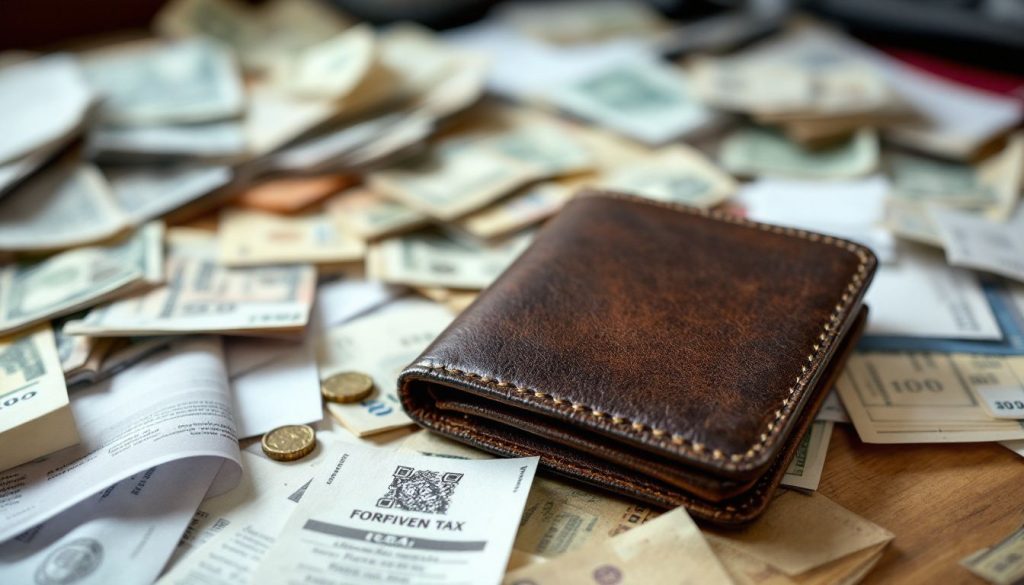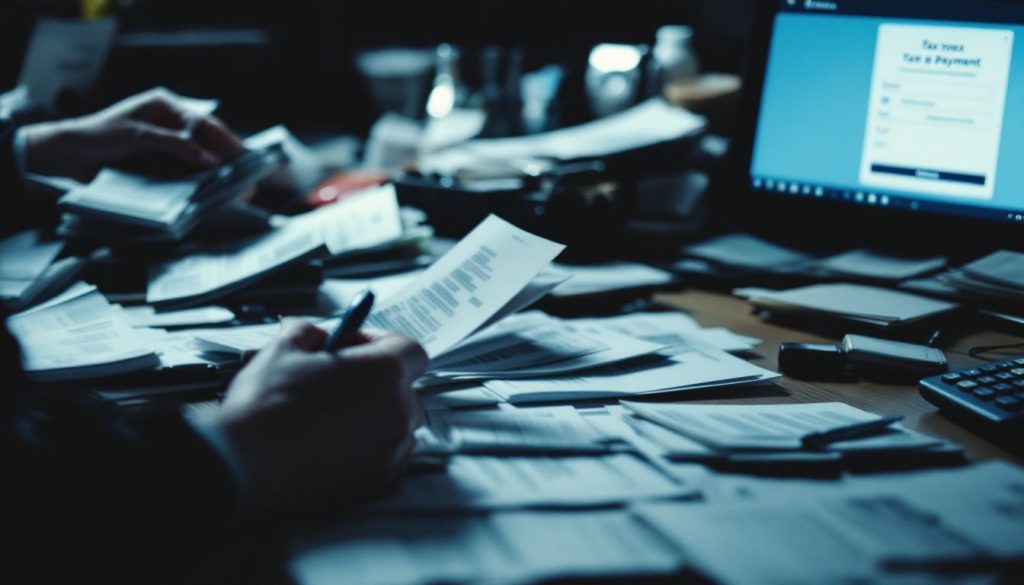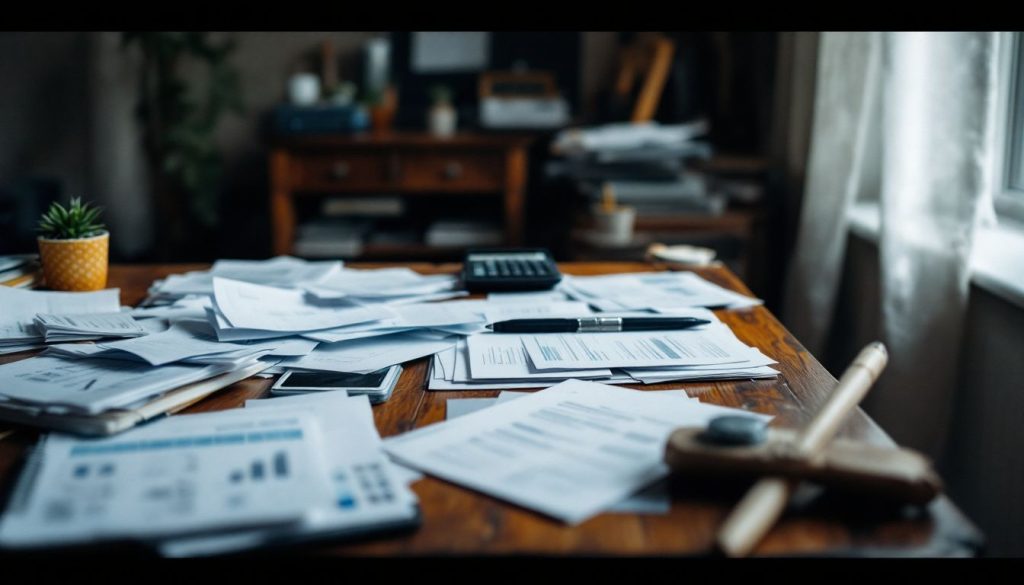Dealing with outstanding debt CRA can be tough. The Canada Revenue Agency offers help for those who can’t pay all at once. This blog will show ways to manage your debt, avoid trouble, and keep calm about money.
Keep reading to learn more!
Key Takeaways
- You can set up a payment plan with CRA if you owe money. This lets you pay over time.
- Not paying your debt to CRA can lead to penalties, like interest and taking money from your paycheck.
- If it’s hard to pay all at once, contact CRA right away. They have options to help.
- You might get some debt forgiven under special rules. Ask about this if needed.
- Use online tools to manage your debt. Check your CRA account often and look into getting professional advice too.
Understanding Your Outstanding Debt with the CRA
Outstanding debt with the CRA can come from various sources. Knowing about these debts is key to managing your finances effectively.
Types of debt collected by the CRA
The Canada Revenue Agency (CRA) collects different types of debt. This includes income tax owed, COVID-19 benefits that were overpaid, subsidies, and other CRA overpayments. Many Canadians may not realize that they owe money back to the CRA for these benefits and credits.
Not paying this debt can lead to penalties and interest on the amount owed. The consequences of not addressing your tax debts may affect child tax benefits too. The CRA has specific methods for collecting outstanding debts when individuals do not pay their assessed taxes.
Ignoring your debt can make things worse.
Consequences of not paying your debt
Not paying your debt with the CRA can lead to serious problems. Penalties and interest will add on to what you owe. The CRA collects outstanding debts from those who fail to pay their taxes on time.
If you ignore your payments, they may garnish your income or freeze your bank accounts. This means the CRA can take money directly from your paycheck or savings without your permission.
Late payments can also hurt your credit history. A bad credit score makes it hard to borrow money in the future. You might face actions taken by the government for unpaid debts. Seeking help early can prevent these issues from growing worse.
Next, we will explore how to effectively manage your outstanding debt with the CRA.
Options for Managing Your Outstanding Debt
You have choices for managing your debt. You can set up a payment plan or review your income and expenses to find what works best.
Making a payment plan with the CRA
Making a payment plan with the CRA can help if you owe money. This option allows you to pay your tax debt over time.
- Contact the CRA: Start by reaching out to the Canada Revenue Agency. They have a specific phone number for collections. Call them to discuss your situation and express your need for a payment plan.
- Assess Your Finances: Look at your income and expenses. Calculate how much you can afford to pay each month. Be honest about your financial situation.
- Propose a Plan: Offer a realistic monthly payment amount based on what you can afford. The CRA is open to working with you, especially if you show genuine effort.
- Get Confirmation: After agreeing on a plan, ask for written confirmation from the CRA. This document should outline the terms of your payment arrangement.
- Make Payments On Time: Follow through with your agreed payments every month. Late or incorrect payments can lead to penalties and further actions by the CRA.
- Stay Informed About Your Account: Sign in to your CRA online account regularly. Check for any updates regarding your debt and see if everything is on track.
- Communicate Regularly: Keep in touch with the CRA throughout your repayment plan. If something changes in your financial situation, let them know right away so they can adjust the plan if needed.
- Consider Full or Partial Payments: If possible, make extra payments when you can afford it. Paying more than your monthly amount will help reduce interest and clear the debt faster.
- Look into Debt Forgiveness Options: There may be ways to get some relief from certain debts owed to the government under specific circumstances, such as applying for debt forgiveness through available forms.
- Seek Professional Help If Needed: If managing this process feels overwhelming, consider talking to a financial advisor or credit counselor who knows about tax debts and CRA processes.
Managing outstanding debt with the government doesn’t need to be stressful if you take proactive steps like making a payment arrangement with the CRA.
Calculating your monthly income and expenses
Calculating your monthly income and expenses is key to managing outstanding debt. Knowing your financial situation will help you make a payment plan with the CRA.
- List all sources of income. Include your salary, any benefits, or subsidies from the government. This shows how much money you bring in each month.
- Write down all your regular expenses. These may include rent or mortgage, utilities, groceries, and transportation costs. Make sure to include any debt payments or taxes owed to the CRA.
- Separate essential expenses from non-essential ones. Essential expenses are things you need for daily living like food and housing. Non-essential ones can be cut if needed.
- Calculate total income by adding up all sources of income listed earlier. This gives you a clear view of what you earn every month.
- Add up all regular expenses to find out how much you spend monthly. This helps identify areas where you might save money.
- Subtract total expenses from total income to see what is left over each month. If the result is positive, that’s good news! You can use those extra funds for paying down debt.
- Review this calculation regularly to stay on top of your finances. Changes in employment or spending habits can affect your numbers.
- Use an online budgeting tool if it helps simplify calculations and tracking spending over time.
- Set aside a portion of leftover money toward making payments on tax debts with the CRA as part of effective management techniques for outstanding debts.
- If necessary, seek professional help to understand complicated financial situations better or if you’re unable to pay full amounts owed to the CRA due to high-interest rates or penalties associated with outstanding debts.
Sign in to your CRA online account
After calculating your monthly income and expenses, the next step is to sign in to your CRA online account. This account is a useful tool for managing outstanding debt with the government.
You can view your tax debts and any benefits you owe. It helps you stay updated on payment options.
Making payments online is convenient. You can pay either in full or partially based on what you can afford. The CRA allows due dates for amounts owed, so keeping track of these dates helps avoid penalties and interest charges.
Signing in also gives access to forms for seeking debt forgiveness under certain circumstances, which may provide relief from your debts.
Consequences of Not Paying Your Debt
If you do not pay your debt to the CRA, there can be serious consequences. You may face penalties and increased interest rates on what you owe.
Potential penalties
The Canada Revenue Agency (CRA) can impose penalties if you do not pay your outstanding debt. These penalties can add to the total amount you owe. Interest also builds up on unpaid debts, making the situation worse over time.
You may face income garnishment as a consequence of not paying your taxes or benefits back to the CRA. This means they can take money directly from your paycheck or bank account. Ignoring this debt may lead to legal collection actions by the CRA, which could complicate your financial situation further.
Garnishment of income and accounts
Garnishment of income and accounts is a way the CRA collects outstanding debt. If you owe money, they can take part of your wages directly from your paycheck. This means you will see less money in your bank account each payday.
Additionally, the CRA can freeze your bank accounts. They may take funds up to the amount you owe. These actions often come after other collection methods fail. It is important to act quickly if you are facing these consequences.
Making payment arrangements with the CRA can help prevent garnishment and keep your finances stable.
Legal collection actions
The CRA can take legal collection actions if you do not pay your debt. These actions may include garnishing your income or bank accounts. Once they decide to collect, the agency will use various methods to recover what you owe.
This can lead to serious consequences for individuals who ignore their debts.
Penalties and interest may apply when owing money to the government. Legal collection actions can also affect future benefits like child tax credits. If you are unable to pay in full, reach out to the CRA as soon as possible.
A payment arrangement might help spread your payments over time based on what you can afford.
How to Effectively Manage Your Outstanding Debt
Stay on top of your payments and keep in touch with the CRA. This helps prevent more issues later. You can ask for a clearance certificate when you settle your debt. If money is tight, reach out for help right away.
There are many resources available to assist you. Read on to learn how to take control of your debt effectively!
Staying up to date with obligations
Paying taxes on time is very important. Owing money to the Canada Revenue Agency (CRA) can lead to penalties and interest. The CRA will take action if you do not pay your assessed taxes.
Making minimum payments helps manage your debts effectively. It is smart to pay down the debt with the highest interest first.
Check your CRA online account regularly. This way, you stay informed about what you owe and any deadlines that may apply. You can also make full or partial payments online, by mail, or in person.
Staying on top of these obligations can help prevent further collection actions from the CRA.
Communicating with the CRA
Staying in touch with the CRA is key for managing your outstanding debt. If you owe money, reach out to them right away. The CRA has options for payment arrangements if you can’t pay your taxes fully.
It allows individuals to spread their payments over time based on what they can afford.
You can contact the CRA collections department by phone or through your online account. Use this communication to ask about a clearance certificate or any other concerns related to debt repayment.
Clear conversations help reduce misunderstandings and keep you informed about important deadlines, penalties, and interest rates that might apply to your situation.
How to request a clearance certificate
A clearance certificate from the CRA shows that you have paid your debts. It can help clear your record with the government.
- Check Your Eligibility
Ensure you meet the rules for a clearance certificate. All your taxes should be filed. You must not owe any money to the CRA.
- Gather Required Information
Collect documents that prove you paid your debts. This may include proof of payments and tax returns for previous years.
- Complete the Application Form
Fill out Form RC326, “Application for a Clearance Certificate.” Make sure all sections are complete and accurate.
- Submit Your Application
Send your completed form to the CRA by mail or online through your CRA account. Include any supporting documents.
- Wait for Processing
The CRA will review your application. This process can take several weeks, so be patient.
- Receive Your Certificate
If approved, you’ll get a clearance certificate in the mail or through your online account. Keep this document safe as proof of payment.
- Contact CRA if Needed
If you do not receive a decision within 30 days, contact the CRA collections phone number for updates on your application status.
- Know What Happens Next
If there are issues with your application, the CRA will notify you of needed changes or additional information required.
These steps will help you successfully request a clearance certificate with the CRA and manage outstanding debt effectively.
What if you cannot afford to pay?
If you cannot afford to pay your debt, talk to the Canada Revenue Agency (CRA). They offer options for people struggling with income tax or other debts. You can set up a payment arrangement.
This lets you break down your payments over time based on what you can pay.
You may also qualify for CRA debt forgiveness in certain situations. It is important to make minimum payments on all debts, if possible. Extra money should go towards the debt with the highest interest rate.
Communicate openly with the CRA about your situation and explore all available debt recovery options.
Seeking professional help.
Finding help is key for those who cannot pay their debts. Many Canadians face challenges with outstanding debt to the CRA. Seeking professional help can make a big difference. Experts understand debt management and can guide you through options like payment arrangements.
Many people look into CRA debt forgiveness or relief programs. Professionals can assist in filling out necessary forms correctly. They know the rules about garnishment of income and accounts for debt collection too.
Understanding your situation better helps you avoid penalties for owing money to the government. Getting support often leads to better financial health and peace of mind.
FAQs
1. What does it mean to manage my outstanding debt with the CRA effectively?
Effective management of your outstanding debt with the CRA means understanding your tax debts, knowing payment options available, and being aware of interest and penalties for late or incorrect payments.
2. How can I set up a payment arrangement with the government for my tax debts?
You can contact the CRA directly using their provided contact information to discuss setting up a payment arrangement. This method helps in financial management and prevents further debt consequences.
3. What are some methods for recovering from debt with the government?
Debt recovery methods include making full payments, setting up a payment arrangement, consolidating your debts or seeking a debt settlement which may have certain tax consequences.
4. What is a clearance certificate in relation to government debt?
A clearance certificate from the government confirms that all amounts you owed for which they could hold you responsible are paid or otherwise settled.
5. What happens if I make late or incorrect payments towards my outstanding debts to the CRA?
Late or incorrect payments may result in additional interest and penalties imposed by the CRA on top of your existing tax debts.









